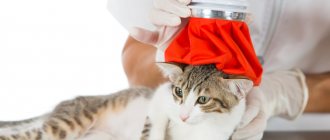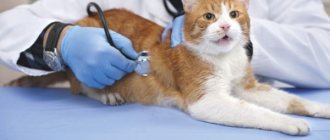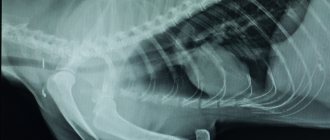Many cat owners experience scratching in their pets. Often this is just a symptom that indicates some more serious disease in the animal. In the initial stages, scratching does not cause any particular problems for the cat, and owners often do not pay attention to it.
This is wrong, because many diseases are curable only in the first stages, and some skin infections of cats can be dangerous to humans. Let's look at why a cat may scratch, how to help your pet at home, and in what cases you should consult a doctor.
Diagnosis of scratching
There are many reasons why a cat may scratch. Minor allergies, parasites, fungi and even some diseases of the internal organs can lead to the fact that the pet begins to scratch itself until there are bloody wounds. Determining the exact cause of such a violation can sometimes be very difficult. In most cases, it is impossible to do without the help of a veterinarian and numerous tests.
Veterinarians distinguish two types of scratching:
- Local. Appear in one or more places. The muzzle, neck and withers are most often affected.
- Generalized . The cat scratches its entire body until it bleeds.
Without proper and timely treatment, the local type may well become generalized.
Most often, lichen infection leads to scratching. This is a disease contagious to humans. That's why you shouldn't ignore it if your pet suddenly starts itching a lot. Diagnosing a lichen infection is quite simple: almost any veterinary clinic has a Wood's lamp, under which the fungus will appear.
If not, you will need to take a skin scraping. Hairs and skin flakes should also be examined. The fungus is often complicated by a bacterial infection.
Information needed to be collected:
- when exactly did the cat start itching?
- with whom and what did she contact before;
- whether other symptoms of the disease appeared.
Itching can appear as a result of an allergic reaction to new food, pollen, or flea bites. There are especially advanced cases when an animal is allergic to dust.
The easiest way to identify food allergies is by introducing new foods into your diet one by one. But only tests will help determine non-food allergies.
Severe stress can also lead to itching. In this case, it is impossible to diagnose it in a clinical setting.
Sometimes skin problems are one of the symptoms of internal organ disease. In this case, you will have to conduct a full diagnosis of the pet’s health condition. To do this, the following research should be carried out:
- general blood analysis;
- fecal analysis for helminths;
- Ultrasound of internal organs;
- skin biopsy.
Cat dandruff.
Dandruff can appear on the back, tail, and head of a pet. There are several reasons. The main ones: allergies to food, too dry air at home, reaction to the sun, the presence of parasites, vitamin deficiency (lack of vitamins A and B). First of all, eliminate potential allergens, purchase food for a healthy coat and for some time include foods rich in vitamins A and B in your cat’s diet - meat, fish oil, eggs. Learn proper nutrition for cats.
Daily brushing has a beneficial effect - a kind of massage that supplies the hair follicles with oxygen.
Also try bathing your cat with a veterinary shampoo with an antifungal effect - SynergyLabs Veterinary Formula with ketoconazole. The product is applied twice a week for 10 minutes, then washed off. What's good? The shampoo contains a powerful antifungal component. Excipients - aloe and lanolin soothe the skin, nourish it and protect it from bacteria. If the cause of dandruff is a fungus, shampoo will eliminate the problem.
Causes of itching
Owners do not always immediately begin to sound the alarm when they discover scratching on their pet. Often they believe that this is not a very serious problem. If the scratching is minor and the itching does not particularly bother the cat, the owner can completely ignore this problem. But it is worth remembering that many diseases are curable only in the first stages. Therefore, it is important to promptly find out the cause of itching and provide professional help to your pet.
Lichen
This is an extremely contagious fungal disease that is also dangerous for humans. It is easily transmitted from a sick animal to a healthy one through short bodily contact, or even through grooming items (combs, nail clippers). Without timely treatment, lichen in dogs, like in cats, can lead to serious consequences for the health of the animal.
You might be interested in: What do black dots in a cat’s fur indicate?
The main symptoms of lichen infection:
- The coat appears unhealthy. A large number of broken hairs.
- Small bald spots appear, which the cat actively scratches. They can be found primarily on the head, neck and paws.
- Hard crusts appear on bald spots.
- Lost fur grows back very slowly.
- Dandruff appears on the skin.
- In the final stages, purulent lesions form.
Skin parasites
Fleas are a very common parasite, especially among cats that have free access to the outdoors. Fleas are quite dangerous, because their bites lead to a decrease in the animal’s immunity. The cat becomes vulnerable to various bacteria and fungi. Flea bites cause severe itching, causing the animal to constantly scratch. Particularly sensitive cats may scratch their skin until it bleeds.
Your cat can also pick up ticks, lice and coccidia. However, the animal does not have to go outside for this. The owner may well bring some parasites with him on shoes and clothes.
The main symptoms of infection with skin parasites:
- deterioration in the appearance of fur;
- severe itching;
- anxiety;
- fleas and ticks can be seen visually if you look closely at the animal’s skin.
A tick bite can lead to quite serious consequences. At the same time, the animal’s temperature may rise, loss of appetite, and decreased activity.
It is best to consult a veterinarian to remove a tick. If the procedure is performed incorrectly, parts of the tick may remain in the animal's skin, which can cause a purulent abscess to form.
Allergy
An allergic reaction can occur completely unexpectedly in any cat. Most often, animals suffer from food allergies. It often manifests itself when changing the diet or adding new foods to it. Food allergies are the easiest to identify and therefore easy to combat.
But when diagnosing non-food allergies, problems can arise. In this case, it is not always possible to determine which allergen caused the body’s negative reaction.
An allergic reaction can be caused by:
- individual food products (often chicken and milk);
- pollen and plant parts;
- flea and tick bites;
- various chemical elements contained in cleaning products and perfumes;
- dust.
Otitis
Otitis of the external ear is a serious disease that can cause many problems for the animal. Infection of the ear canals leads to inflammation. The cat constantly shakes its head and scratches its face until it bleeds.
The main symptoms of otitis in a cat:
- redness of the ear;
- anxiety;
- the cat constantly shakes its head;
- the animal scratches its ears and muzzle;
- increased body temperature;
- In the absence of timely treatment, pus may begin to leak from the auricle.
Worms
Even completely domestic cats are not immune from infection with worms. Parasite eggs can enter the animal's body through raw meat, unwashed hands, clothing, and grass. Infection with helminths leads to decreased immunity and disruption of the body.
The main symptoms of helminth infection:
- Deterioration in the appearance of the coat, scratching.
- Defecation disorder.
- The animal quickly loses weight.
- Itching in the area of the anus, which causes the animal to rub it on the floor and carpets.
- Decline in activity or, conversely, excessive anxiety.
- In advanced cases, severe shortness of breath occurs.
Bacterial diseases
Bacteria and fungi are found in small quantities on the skin of any cat. Usually, they do not cause any problems to the animal. But if the animal gets sick, its immunity is reduced, and the body is weakened, fungi and bacteria begin to actively multiply, which often leads to severe itching and scratching.
You might be interested in: What causes red spots on a cat's tongue?
At risk are cats that already suffer from diabetes, allergies, and hyperthyroidism. This problem often occurs in kittens.
One of the most common bacterial infections in cats is pyoderma . Its main symptoms:
- severe itching;
- peeling of the skin;
- Scabs form on the wounds;
- baldness of certain areas of the skin;
- formation of purulent abscesses.
Pyoderma is very dangerous for cats. When the first symptoms appear, you should immediately consult a doctor.
Stress
All animals experience stressful situations differently. For some, moving or even ordinary fear can lead to not entirely adequate reactions. Constant licking of the same places may indicate mental disorders of the animal.
Of course, such a diagnosis can only be made after all other possible causes of itching have been excluded during the diagnostic process. The main symptoms of mental disorders and stress:
- refusal to eat;
- a decrease in activity or, conversely, excessive excitability;
- the animal constantly scratches or licks one place.
Breeds in which this problem most often occurs: Burmese, Orientals, Abyssinian and Siamese cats.
Disruption of hormone production
Disruption of the endocrine system leads to the appearance of various symptoms, including itching and scratching. A number of diseases that cause disruption of hormone production:
- Diabetes.
- Cushing's syndrome.
- Thyroid dysfunction.
Main symptoms:
- Hair loss and bald patches.
- Dryness and flaking of the skin.
- Severe itching and scratching.
Fleas
Infection with ringworm or tinea versicolor, the appearance of allergic reactions from flea bites will require treatment not only of the animal, but also of its owner. Cat skin diseases are not life-threatening. Should you treat your pet yourself? If this is your first time, definitely not. If treated incorrectly, sores will spread throughout the body and appear on the tail, back, paws, ears and head.
Lice and fleas are small insects that feed on blood and the top layer of skin. If the case is advanced, it is impossible not to notice them on the pet. Favorite localization is around the tail and head.
At an early stage, an accumulation of a black substance, a waste product of fleas, is noticeable. Also, the pet experiences itching, hair loss, redness of the skin, and the formation of wounds.
Lice are eliminated using a special shampoo. Fleas are removed by treating things with which the pet comes into contact with anti-flea agents, carriers, bedding, and all carpets in the house.
Even the apparent absence of fleas upon examination does not mean that they do not exist at all. Nits are attached to the animal's fur - lice eggs, which look like black grains of extremely small size. If such spots are found, the cat should be treated with special flea drops. The animal's bed should also be treated with a special spray. The itching caused by fleas will soon cease to bother you.
They are not dangerous to humans, but they can bite him - red itchy blisters appear on the body. Bars drops are effective in the fight against fleas. They are applied to the withers so that the animal cannot lick them off. Drops are absorbed through the skin into the animal's blood. The concentration is not dangerous for the cat, but is destructive for fleas.
When carrying out anti-flea measures, thoroughly clean the apartment, because... Nits and fleas may remain. Fry the cat's bedding and house in the sun.
Treating scratches at home
If a cat scratches itself until it bleeds, the first step is to treat the wound so that it does not get infected. Regular human ointments are suitable for this.
To avoid further scratching of the skin, the cat should trim its claws and cover the problem area with something (for example, put a special collar or vest on the animal).
If a doctor has diagnosed lichen, the sick animal must be isolated from healthy ones. The fur next to the affected area is shaved off. The affected area is treated with ointments.
If an animal is taking any anti-inflammatory or immunosuppressive drugs, they should be stopped for a while so that the body has the strength to cope with the fungus.
The room in which the cat lives, as well as all objects with which it comes into contact, must be disinfected. Treatment of lichen can take quite a long time, but if its initial stages are detected, the animal will fully recover.
A special diet will help overcome food allergies. A product that causes a negative reaction should be excluded from the diet. You can also purchase commercial food for cats prone to allergies.
Atopic dermatitis can also cause itching. This is also an allergic reaction of the cat’s body, but it is impossible to isolate the exact allergen and completely eliminate it. Atopic dermatitis cannot be cured, but with the help of medications, all negative manifestations of allergies can be eliminated.
If a cat is suffering from a bacterial infection, the first step is to use various ointments. If an animal develops ulcers, the doctor will prescribe a course of antibiotics.
If the disease becomes chronic, the veterinarian takes microbiological tests. This is necessary to prescribe the most effective treatment for this type of bacteria.
When do you need veterinary help?
Often, scratching is almost harmless and does not cause the animal much discomfort. The owner may not even immediately notice that something is wrong with the pet. Problems begin when bacteria get into the wound. In this case, an abscess may form on the skin. In some cases, without timely treatment, the area of scratching may increase.
You might be interested in: Why do my cat's ears fester?
If an animal scratches a small wound once, there is no need to sound the alarm. Perhaps the cat just overdid it. The wound should be treated and the pet should be monitored.
In what cases should you take your pet to the veterinarian:
- The cat scratches the same place for a long time until it bleeds.
- The area of scratching increases.
- The wound oozes pus or does not heal.
- Scabs form on the affected area of the skin.
- The cat's hair falls out and bald patches form.
- The animal is constantly itching.
Scratching is often one of the symptoms indicating that the animal is unhealthy. In this case, you should pay attention to the general condition of the cat. You should contact your veterinarian if the following symptoms accompany itching:
- Decreased activity or excessive agitation.
- Increased body temperature.
- Lack of appetite.
- Nausea, vomiting, diarrhea.
Scabies.
A rare disease for cats. Dangerous to humans, like lichen. The causative agent is the scabies mite. It manifests itself as hair loss, itching, rashes with white liquid inside. It is treated by bathing the pet with hexachlorane emulsion or using soap. The following oils have a healing effect: tea tree and sea buckthorn.
We suggest you read: Signs of why lice appear
The most dangerous skin disease in cats. The causative agent is a skin mite. When bitten, a swollen red spot forms, hair falls out on the face, bloody spots and pimples appear - pressing on which will provoke the outflow of white liquid with a large number of microscopic larvae. Sulfur ointment, veterinary drugs Stronghold and Advocad cope with demodicosis. You can also use human shampoo from the StopDemodex series.
For prevention, provide your pet with a balanced, fortified diet.
Demodicosis
Demodicosis is an extremely dangerous disease for a pet. It can lead to the death of a cat instantly, sometimes the owner does not even have time to start treating it. Demodicosis appears due to the bite of ticks, which are numerous in the warm season.
Cats cannot take preventive and protective measures themselves, so they often become their victims. Symptoms: damage to large areas of skin, itching, redness. The worst thing is that if a pet gets sick once, then it becomes a constant source of infection. His offspring will also suffer from demodicosis.
It is important to take preventive measures - treat the skin with products that kill ticks (Bars, Harts). It is also worth using anti-inflammatory drugs (Dexafort, Laurabolin 50) and anti-itch drugs (Stop-itch).
Another common cause of body sores in cats is demodicosis. This is a tick, called subcutaneous because of its location. Demodex, which is the name of the causative agent of this disease, affects all cats and dogs, regardless of age and breed.
Modern veterinarians believe that demodex activity is caused by:
- weakened immunity (due to recent illnesses, chronic and congenital changes and diseases);
- poor quality maintenance (untimely cleaning of the tray, dirty house and bedding, dampness in the room, dirt);
- unbalanced diet (lack of fat and vitamin A in the diet).
Eczema
Eczema is an unpredictable disease.
Appears due to many factors, including:
- Severe skin contamination with parasites, dirt, bacteria;
- Improper wearing of collars and synthetic clothing for cats;
- Complication of any disease (pathology of the nervous system, kidney disease, stomach and liver).
The main symptom is a weeping surface of the skin. Scratching causes knots and redness to form. The cat is rapidly losing weight, has a fever and kidney problems.
For diagnostic purposes, the veterinarian will take a skin scraping to rule out the possibility of other diseases. Afterwards he should prescribe antihistamines. You should not try to treat your cat without a doctor, as complications may develop.











